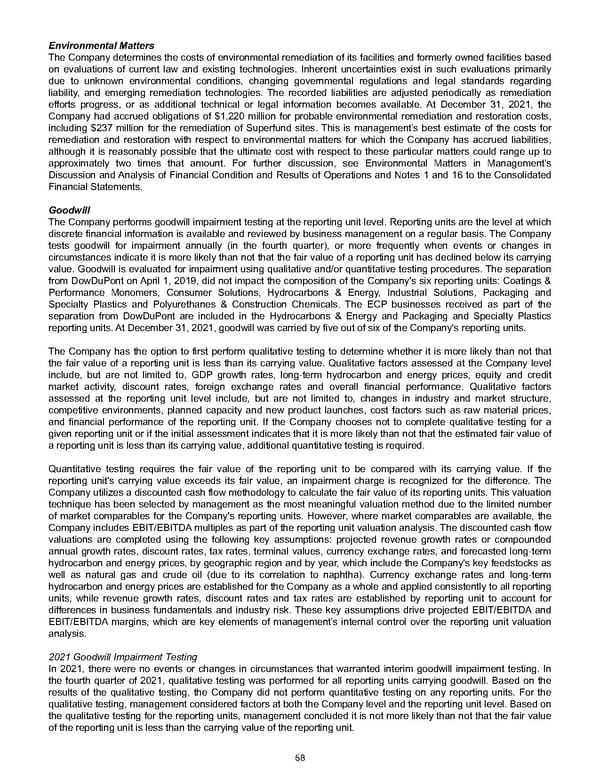Environmental Matters The Company determines the costs of environmental remediation of its facilities and formerly owned facilities based on evaluations of current law and existing technologies. Inherent uncertainties exist in such evaluations primarily due to unknown environmental conditions, changing governmental regulations and legal standards regarding liability, and emerging remediation technologies. The recorded liabilities are adjusted periodically as remediation efforts progress, or as additional technical or legal information becomes available. At December 31, 2021 , the Company had accrued obligations of $1,220 million for probable environmental remediation and restoration costs, including $237 million for the remediation of Superfund sites. This is management’s best estimate of the costs for remediation and restoration with respect to environmental matters for which the Company has accrued liabilities, although it is reasonably possible that the ultimate cost with respect to these particular matters could range up to approximately two times that amount. For further discussion, see Environmental Matters in Management’s Discussion and Analysis of Financial Condition and Results of Operations and Notes 1 and 16 to the Consolidated Financial Statements. Goodwill The Company performs goodwill impairment testing at the reporting unit level. Reporting units are the level at which discrete financial information is available and reviewed by business management on a regular basis. The Company tests goodwill for impairment annually (in the fourth quarter), or more frequently when events or changes in circumstances indicate it is more likely than not that the fair value of a reporting unit has declined below its carrying value. Goodwill is evaluated for impairment using qualitative and/or quantitative testing procedures. The separation from DowDuPont on April 1, 2019, did not impact the composition of the Company's six reporting units: Coatings & Performance Monomers, Consumer Solutions, Hydrocarbons & Energy, Industrial Solutions, Packaging and Specialty Plastics and Polyurethanes & Construction Chemicals. The ECP businesses received as part of the separation from DowDuPont are included in the Hydrocarbons & Energy and Packaging and Specialty Plastics reporting units. At December 31, 2021 , goodwill was carried by five out of six of the Company's reporting units. The Company has the option to first perform qualitative testing to determine whether it is more likely than not that the fair value of a reporting unit is less than its carrying value. Qualitative factors assessed at the Company level include, but are not limited to, GDP growth rates, long-term hydrocarbon and energy prices, equity and credit market activity, discount rates, foreign exchange rates and overall financial performance. Qualitative factors assessed at the reporting unit level include, but are not limited to, changes in industry and market structure, competitive environments, planned capacity and new product launches, cost factors such as raw material prices, and financial performance of the reporting unit. If the Company chooses not to complete qualitative testing for a given reporting unit or if the initial assessment indicates that it is more likely than not that the estimated fair value of a reporting unit is less than its carrying value, additional quantitative testing is required. Quantitative testing requires the fair value of the reporting unit to be compared with its carrying value. If the reporting unit's carrying value exceeds its fair value, an impairment charge is recognized for the difference. The Company utilizes a discounted cash flow methodology to calculate the fair value of its reporting units. This valuation technique has been selected by management as the most meaningful valuation method due to the limited number of market comparables for the Company's reporting units. However, where market comparables are available, the Company includes EBIT/EBITDA multiples as part of the reporting unit valuation analysis. The discounted cash flow valuations are completed using the following key assumptions: projected revenue growth rates or compounded annual growth rates, discount rates, tax rates, terminal values, currency exchange rates, and forecasted long-term hydrocarbon and energy prices, by geographic region and by year, which include the Company's key feedstocks as well as natural gas and crude oil (due to its correlation to naphtha). Currency exchange rates and long-term hydrocarbon and energy prices are established for the Company as a whole and applied consistently to all reporting units, while revenue growth rates, discount rates and tax rates are established by reporting unit to account for differences in business fundamentals and industry risk. These key assumptions drive projected EBIT/EBITDA and EBIT/EBITDA margins, which are key elements of management’s internal control over the reporting unit valuation analysis. 2021 Goodwill Impairment Testing In 2021, there were no events or changes in circumstances that warranted interim goodwill impairment testing. In the fourth quarter of 2021, qualitative testing was performed for all reporting units carrying goodwill. Based on the results of the qualitative testing, the Company did not perform quantitative testing on any reporting units. For the qualitative testing, management considered factors at both the Company level and the reporting unit level. Based on the qualitative testing for the reporting units, management concluded it is not more likely than not that the fair value of the reporting unit is less than the carrying value of the reporting unit. 58
 Annual Report Page 67 Page 69
Annual Report Page 67 Page 69